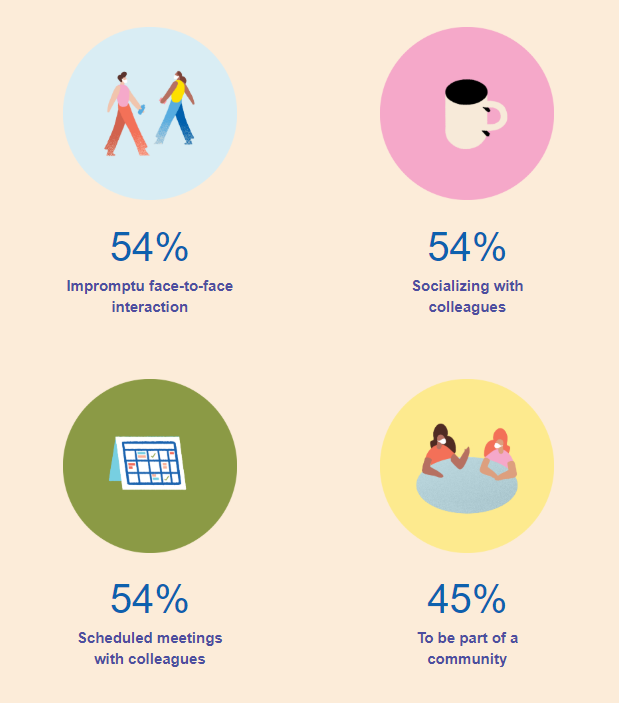We use cookies to make this site as useful as possible and maximize your experience. By closing this message, you consent to our cookies on this device in accordance with our cookie policy unless you have disabled them in your browser settings.
Work From Home Strategies Pt. 3

This article is the third in a series on work from home strategies in the post-COVID era. Read parts one and two here.
The next—very common—work-from-home misconception rests on the shoulders of the workers themselves.
Misconception #2
“People are just as (or more) productive at home as they are in the office.”
The nuances of that assumption paint a different picture. How is the boss defining productivity? Some forms of work are easily accomplished at home. But true productivity relating to creativity, innovation and transformation are notoriously difficult to measure in the short-run and incredibly hard to accomplish virtually. This is especially true in the panic and stress of a pandemic.
Great ideas can’t be scheduled. The ebb and flow needed for the creative process can’t happen in a series of short online meetings. People who are together, building on each other’s ideas while working with the same information, can more easily ideate and solve problems.
Reality: Individual task work is up. Collaboration and creativity are down.
Short meetings are skyrocketing, and longer meetings are decreasing according to a study of Microsoft’s 300-person Modern Office team. Shorter meetings seem, on the surface, to increase productivity. The reality is exhaustingly different. In the words of one tech leader, “We’re doing full days of wind sprints from one meeting to the next,without time to process or think about the outcome of the meeting, let alone take action on it.” In essence, collaboration is a lot harder.
62.6 percent saw a decline in time spent working with others (Steelcase Workspace Futures research)
55 percent say collaborating with others is harder working from home (Gensler’s U.S. Work from Home Survey 2020)
Some studies suggest online collaboration has proven to be successful during the crisis. But it’s important to recognize there are three types of collaborative work:
- Informative: sharing information or coordinating tasks
- Evaluative: considering options, making choices
- Generative: creating new ideas and solving complex problems
Reality: Proximity and social accountability boost productivity.
Informative and evaluative collaboration can take place on video chat. But generative collaboration is the most challenging in any condition, and the most difficult to replicate online. In an all-virtual environment, people struggle to have normal flow of conversation and read body language while sharing content. Both are critical behaviors for innovation. In a recent Wired interview, Google CEO Sundar Pichai seemed to address this exact issue when he questioned if virtual teams would still be productive if they needed to brainstorm and be creative when they have not previously worked together in person.
Reality: Proximity and social accountability boost productivity.
Well-established science has long proven proximity enhances team productivity. Olson (UC Irvine, formerly at University of Michigan) co-led a study at Ford that showed teams working in the same room doubled productivity versus previously when they worked on separate floors. People can read each other’s body language, jump in when help is needed and get questions answered quickly, she notes. The rise of agile work, which emphasizes co-location, has reinforced these learnings. Additionally, studies show that people tend to work harder when surrounded by others who work harder — a concept called “social facilitation.” In fact, people run faster, are more creative and think harder about problems when they have an audience, as cited by Harvard Business Review.
Distractions at home can make it hard to focus. When asked why they want to go back to the workplace, people say they want to be with others. It’s those in-person moments that help people be more productive and feel a sense of purpose.
Reality: We might be creating a “lost generation at work.”
Working from home full time disproportionately affects millennial and Gen Z workers. They report feeling the least accomplished of all generations, failing to understand how their work at home contributes to company goals and what’s expected of them (Gensler U.S. Work from Home Survey 2020). Only 35% of both groups feel like they’ve made a difference working from home. Those numbers are only slightly larger for Gen X (39%) and Baby Boomers (44%). Remote work also decreases networking opportunities and the chance for mentorship. In fact, professional development and coaching is a reason one-third of all workers want to go back to the office. Adopting an extreme work-from-home policy could impact the ability for organizations to grow the next generation of leaders.
Reality: Work is inherently social. Serendipity is absent online.
Ask people what they miss most about the office, and not surprisingly 74% say “the people,” according to Gensler’s US Work from Home Survey 2020. But this isn’t just a feel-good metric. Work is inherently a social activity. Respondents cite four top reasons they want to return to the office:

Our interpersonal and professional networks are shrinking as we limit ourselves to interacting with tiny tiles of people with distracting beach backdrops on a computer screen. Hallway conversations are non-existent and meeting new people is increasingly difficult. Steve Jobs is famous for touting the value of running into other people. He talked about “engineered serendipity”—personally having a hand in designing the layout of Pixar’s floorplan to foster unplanned interactions between employees. And Microsoft’s Satya Nadella cautioned against “over-celebrating” in areas where raw productivity metrics rose, saying it’s tough to identify and virtually replicate the value that comes from managing, mentoring and connecting with people before and after meetings. Innovation happens when ideas collide, and people stitch concepts together to create something new. Serendipity can’t be scheduled.
